Author Archives: Eleanor J. Bader
January 7, 2020 by Eleanor J. Bader
How Women Can Get Over Our Fear of Asking for Money
“People will go to jail for things they believe in, but they’re often afraid to ask someone for money,” Marjorie Fine says. This is why she travels the country, teaching grassroots, social justice activists the ins-and-outs of raising money from both foundations and individual donors. For women in particular, asking for money and raising it can provide unique challenges, making Fine’s expertise particularly useful.
Fine learned her craft as a development staffer at a host of organizations: The National Council of Jewish Women, The North Star Fund, the Unitarian Universalist Veatch Program at Shelter Rock, The Center for Community Change, and the now-defunct Reproductive Rights National Network.
- No Comments
December 27, 2019 by Eleanor J. Bader
After Loss, a Devotion to Those Afflicted by AIDS
Not long after nurse and public health activist Elena Schwolsky’s husband, Clarence Fitch, died of AIDS in 1990, she left her job at a Newark, New Jersey, pediatric AIDS clinic, enrolled in graduate school, and went to Cuba to study the island’s AIDS treatment protocols and meet people living with the virus. The result of her six-month stay is the recently released Waking in Havana: A Memoir of AIDS and Healing in Cuba (She Writes Press).
Both deeply personal and deeply political, the book is a reflection on the challenges of living with HIV/AIDS and what it means to deliver humane medical care. The impact of the US embargo on Cuba and the collapse of the Soviet Union are part of the story, but Schwolsky’s focus never wavers from the individuals who are working to eradicate the disease. Likewise, people living with the virus are front-and-center in her moving, and often surprising, account.
Schwolsky sat down with Eleanor J. Bader in mid-December to discuss Waking in Havana, her ongoing AIDS work in Cuba, and the pervasive and persistent misconceptions about the island that continue to be promulgated.
Eleanor J. Bader: After working in a pediatric AIDS clinic and losing your husband to the virus, what made you want to do a deep dive into Cuba’s AIDS crisis?
Elena Schwolsky: I did ask myself if I really wanted to put myself in a Cuban sanitorium, where every resident had the virus and would likely get sicker and sicker. But Clarence had been on the frontlines and it somehow felt comforting to share in this work. It seemed like an important battle. I also think that I had survivor’s guilt. The universe had given me a pass and I felt committed to using my life in a way that had meaning. It gave me an identity, and the camaraderie in the AIDS service community had an urgency that bound us together. Plus, I was curious and wanted to see how the epidemic was handled in a different place.
- No Comments
December 9, 2019 by Eleanor J. Bader
Art in Exile Showcases Work by Artists Who Escaped the Nazis
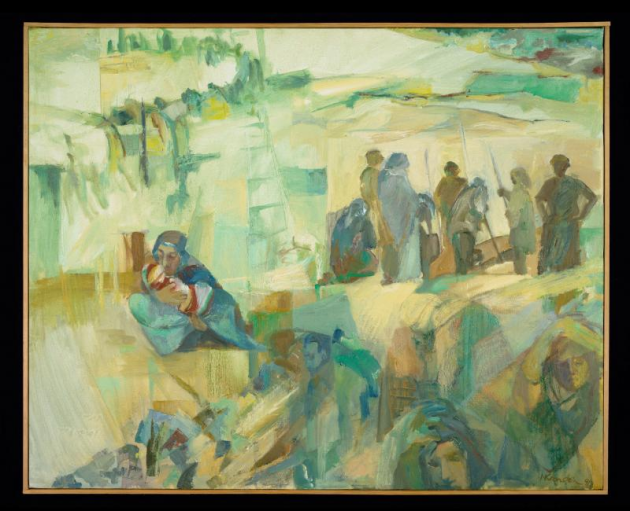
“Old Walls by the Sea” by Mina Krocherthaler, ~1968
Art in Exile, Leo Baeck Institute
Dispossession has been an historical constant, but during World War II thousands of German Jews with the means to escape Hitler’s rule found sanctuary in countries throughout the world. Of course, there were challenges aplenty; still, many thrived, finding personal and professional toeholds wherever they landed.
Some found solace in creativity, something that is showcased in Art in Exile: Paintings by German-Jewish Refugees, an exhibition now on display at New York City’s Leo Baeck Institute (LBI). The show homes in on the creativity of 11 artists who used painting, drawing and collage to explicate their refugee status and illustrate feelings of gratitude, fear, joy, loneliness, and apprehension. Four of the 11 are women.
Dr. Magdalena M. Wrobel, project manager at LBI, notes that in choosing the art, the curators sought a range of styles. But, she adds, they also wanted to illustrate a range of life trajectories. The goal? “To cumulatively demonstrate how an oppressive regime, exclusion, persecution, and finally exile can influence the artistic creativity of those afflicted in various ways.” In addition, Wrobel adds that in order to be included, the works had to be in good condition despite the passage of time and be available for the six-month duration of the show.
- No Comments
November 18, 2019 by Eleanor J. Bader
Through Her Lens: Documenting Crypto-Jews, Brooklyn Life, and More
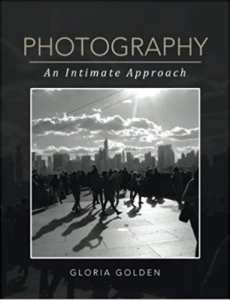
gloriagolden.com
When Gloria Golden was growing up in Brooklyn, New York – first in Bedford-Stuyvesant, and later in Borough Park and Gravesend — her father carried a camera everywhere he went. But his daughter did not follow his example.
Unlike her dad, Golden did not begin to take photographs until 1994, when she took a course at Queensborough Community College during a sabbatical from her job as an elementary school teacher.
Since then, Golden has taken thousands of shots and has published five books of photos and text: Remnants of Crypto-Jews Among Hispanic Americans (2005); Desaturated Soul (2009); Brooklyn Revisited (2012); Photography: An Intimate Approach (2016); and Metallic Metropolis (2019).
Now living on Long Island, the award-winning photographer discussed her career with Lilith’s Eleanor J. Bader in early November.
Eleanor J. Bader: Let’s start by talking about your early years as a public-school teacher, before you found a foothold in photography. Did you like teaching?
Gloria Golden: Let’s go back even earlier. I was born in the 1940s and attended New Utrecht High School in Brooklyn. When I began studying there, I was in the commercial education program, training to be an office worker, because I did not think my parents could afford to send me to college. When I explained this to one of my teachers, she was shocked and called my parents in to discuss my future. After this conversation, I was put on the academic track. When I graduated, I enrolled at what was then called the Uptown City campus of City College. I’d originally assumed I’d teach business classes since that was what I’d focused on during high school, however, I ended up taking classes in elementary education at Uptown City to prepare me to teach elementary school. Martin Luther King spoke at my college graduation. Can you believe it?
- No Comments
November 15, 2019 by Eleanor J. Bader
Fresh Art for Social Change…and Healing
 There is a photocopied sign on the wall of art administrator Suzanne Kreps’ cluttered office: “Change will not come if we wait for another person or some other time…We are the ones we’ve been waiting for…We are the change that we seek.”
There is a photocopied sign on the wall of art administrator Suzanne Kreps’ cluttered office: “Change will not come if we wait for another person or some other time…We are the ones we’ve been waiting for…We are the change that we seek.”
The quote, attributed to former President Barack Obama, reinforces Kreps’ commitment to using art to promote social justice. She’s done this for 16 years, as the executive director of fresh art, a small, New York City-based non-profit that organizes fine art and craft workshops for underserved and disadvantaged adults— seniors, women and men in recovery from chemical dependencies, the homeless, the mentally ill, and people with HIV, AIDS, mental illnesses and physical and emotional disabilities. It also organizes exhibitions of their work.
As Kreps prepares to retire at the end of 2019, she sat down with Eleanor J. Bader to look back on her work with the organization.
Eleanor J. Bader: Let’s start with history. How and when did fresh art begin?
Suzanne Kreps: Wendy Grossman founded fresh art in 1997 and started its programming in 1999. Wendy had been working as a recreational therapist at the now-defunct John Heuss House, a drop-in center for homeless men and women living with mental illness, that was located in Lower Manhattan. This was in the late 1990s. Wendy’s job included organizing group activities as well as art classes, other recreational programming, and activities emphasizing daily living skills. In 1997, she mounted “Inside Out”, a show of works created by the participants. My partner, Clarke, who also worked at John Heuss House, suggested that Wendy contact me since I was working at OK Harris Gallery. I knew a fair amount about arranging exhibitions, so he thought I could help. I assisted in the installation of that show and later became a member of an Advisory Board that helped Wendy form fresh art.
The idea of starting a non-profit arts organization had been with Wendy for some time. She envisioned an organization that would provide programming to a wide-range of underserved and at-risk populations—including disadvantaged youth, homeless and formerly homeless individuals, people with disabilities, and low-income and isolated seniors.
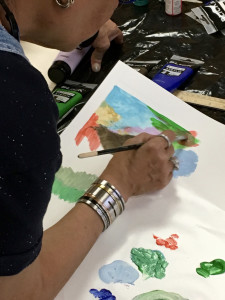 Wendy eventually left Heuss House and with the help of the New York Foundation for the Arts– the fiscal sponsor of the organization while it waited for its 501(c 3) status — she was able to get the fledgling organization off the ground. She began running the organization out of her family’s fifth floor walk-up apartment in the East Village.
Wendy eventually left Heuss House and with the help of the New York Foundation for the Arts– the fiscal sponsor of the organization while it waited for its 501(c 3) status — she was able to get the fledgling organization off the ground. She began running the organization out of her family’s fifth floor walk-up apartment in the East Village.
From the beginning, fresh art arranged exhibitions to showcase the creativity of artists from the populations I just mentioned. One of the first was called “Wild Kingdom” and every piece had something to do with animal life. The art came from programs at the Bowery Residents Committee, St. Francis Residence III in Manhattan, Harlem Hospital, The Point in the Bronx, and five additional NYC organizations.
In April of 1999 the exhibition was installed at CB’s 313 gallery space on the Bowery, located next door to CBGBs. During the next two years, exhibitions were planned at other venues.
Then, in the summer of 2001, Wendy found a rental space in the basement of Washington Square United Methodist Church, another site that no longer exists. It opened in August 2001, a month before September 11th. The space was part office, part gallery, and part gift shop where artworks and crafts by artists affiliated with other non-profit agencies were for sale; fresh art stayed open in this spot until 2003.
- No Comments
November 3, 2019 by Eleanor J. Bader
Toxic Tango: Site-Specific Art for Environmental Crisis
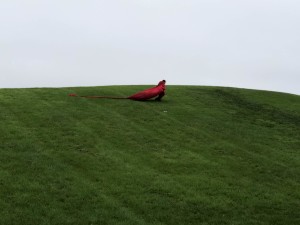
Scarlett Wardrop
When artist Julie Laffin and writer-teacher Jennifer Natalya Fink talk about environmental degradation, they focus on more than rising sea levels, polluted air, fouled waterways, and animal extinction. In fact, their site-specific art project, Toxic Tango, asks viewers to draw connections between our physical, emotional, and public domains, in essence making the personal political and vice-versa.
Performed just twice, in South Bend, Indiana, and Washington, DC, Toxic Tango aims to raise consciousness, unsettle viewers, and provoke debate about how best to promote tikkun olam, the healing of our devastated planet.
Laffin, based in Illinois, and Fink, based in Maryland, spoke to Eleanor J. Bader by phone in early October.
Eleanor J. Bader: Where did the idea for Toxic Tango originate?
Julie Laffin: I have a long history of making gowns and inserting myself into public spaces to promote a particular idea, but after I became disabled 15 or so years ago, I could no longer do this. I have environmental illness. Unfortunately, not much is known about these things. Is it a brain injury? Is it an endocrine disorder? Toxic overload? No one knows. What I do know is that these illnesses are idiosyncratic. People with them have a lot of different symptoms including respiratory difficulties and food sensitivities. Since I can’t easily go into public spaces anymore, but still want to make art that intervenes in public life, I’ve looked for surrogates, other women, who enact the performance pieces I co-create.
Jennifer Natalya Fink: Julie and I went to graduate school together at the School of the Art Institute of Chicago from 1988 to 1990. We connected again over disability – I have a daughter on the autism spectrum and, as she said, Julie has environmental illness. We started talking about doing a performance that addressed environmental contamination and found an opportunity to collaborate in the fall of 2018. I was going to &NOW, a conference at Notre Dame University. The city of South Bend, Indiana, where Notre Dame is located, is very flat, with areas of extreme wealth and areas that are poor and largely African American. LaSalle Park is in the African American neighborhood and was built on a toxic waste site. It looks like a huge mound in an otherwise flat landscape.
Julie and I devised a performance for this park. I wore a beautiful, glamorous, 100-foot-long red dress which played into the spectacle of the female body. The performance involved me running up a huge hill, then rolling down until I was bound up in the dress. At one point I inserted dirt into my stomach via a hidden pouch. As I moved up and down the mound, Julie read the government’s Super Fund Report about the site’s contamination. She was audible through my cellphone. At the end of the performance, we gave out leaflets that explained the context for what we were doing. We informed people that the Park was designated as a Super Fund site in 2013, but that both state and federal officials had known that the land was contaminated as early as 1984. Why, we asked, hadn’t it been cleaned before the park was constructed?
- No Comments
September 18, 2019 by Eleanor J. Bader
This Woman-Owned Business Has Everything You Need to Dress for Activism
If you like to wear progressive politics on your sleeve—or maybe on your coffee/tea/matcha mug or cell phone case—check out HeedtheHum.com, a queer, Jewish, woman-of-color-owned company created and run by Brooklyn activist Rachel Levin.
Heed the Hum’s nearly 2000 products sport a variety of messages, from the word RESIST to Eve & Esther & Miriam & Deborah & Ruth, a celebration of Biblical sheroes. Other products promote world peace or provide a way to declare one’s identity: Black and Brazen; Nasty Woman; Feminist Zionist, among them.
Levin, a professional graphic and web page designer, sat down with reporter Eleanor J. Bader in early September to talk about the challenges of being a feminist entrepreneur.
Eleanor J. Bader: Let’s start with the name of your company, Heed the Hum. What does it mean?
Rachel Levin: I’ve always been an activist and prideful about being queer, Jewish, and of color. But growing up I had deep moments of unhappiness and feelings of loss. I had been adopted at two months old by a straight, white, Jewish couple in Chicago. I was born in Chile, and for a long time kept my shame over being adopted private; it was always on a back burner of my mind though.
I was raised in a very safe, but sheltered, bubble, surrounded primarily by Ashkenazi Jews. They treated me beautifully, but in my gut, I felt like an “other.” I knew I was Chilean, at least by blood, and even though I had food, shelter, and an incredibly loving family — the best parents and a wonderfully supportive and inclusive older brother who was also adopted—there was always this hum that something was a bit off. For many years, I ignored it.
As I got older, I wanted to live fully, out in the open as a queer person, as a feminist, and as a Jewish person of color. To do this, I literally started to heed the hum, to listen to the signs around me. I began to pay attention to what I was feeling both personally and politically. A bit later, when I was in college, I realized that I wanted to help other people become visible and become empowered by what made them an “other.” I also wanted to do something that would start conversations about political issues.
I started Heed the Hum in May of 2017. In the past two years I’ve sold several thousand t-shirts for adults and children, as well as mugs, hats, pillows, posters, pieces of jewelry, flags, totes, and phone cases. The proceeds of The GIVE Collection benefit organizations I support, like the Red Cross and Moms Demand Action for Gun Sense in America. It’s work that I think makes a difference.
- No Comments
September 13, 2019 by Eleanor J. Bader
The Relevance of Grace Paley in the Trump Era
In the late spring of 2016, writer Judith Arcana began to reckon with the probability of Donald J. Trump ascending to the US presidency. “As I watched the emergence of Brexit in the United Kingdom, I was electrified,” Arcana told Lilith’s Eleanor J. Bader in mid-August. “I understood how—and why—Donald Trump could become president.”
This conclusion frightened her; nonetheless, Arcana found solace in thinking about activist-writer Grace Paley (1922-2007), the subject of her 1993 biography, Grace Paley’s Life Stories. “Grace’s life is a model for us right now, in the streets and on the page,” Arcana wrote in the Preface to the recently-released second edition of the book (Eberhardt Press).
Indeed, it’s impossible to read Grace Paley’s Life Stories and not be inspired by her energy, optimism, and fortitude. Add in her literary output—essays, poems, and three short fiction collections—The Little Disturbances of Man (1959); Enormous Changes at the Last Minute (1975), and Later the Same Day (1985)—stories that showcase the everyday interactions of working-class men, women, and children, and it is clear why Paley’s work remains relevant years after her death.
- No Comments
August 1, 2019 by Eleanor J. Bader
Making “Black Hat”: Director Sarah Smith Tells All
As a Lutheran growing up in Minnesota, Sarah Smith had no way to anticipate that she would one day direct a film about a gay-curious Hasidic man living in Los Angeles. But her award-winning film,” “Black Hat” zeroes in on Shmuel [played by Adam Silver], a married father, whose wife and kids are visiting out-of-state relatives. Suddenly footloose, the devoutly observant Shmuel allows himself a brief foray into gay L.A. where he meets Jay [Sebastian Velmont], a man who lives without the constraints of community expectations. What ensues is tender, provocative, and open-ended, a tiny glimpse into a world that is all-too-often exoticized and ridiculed. In a short 14 minutes, the film—written by Phillip Guttmann, produced by Yaniv Rokah, and co-produced by Loriel Samaras and Guttmann—tells a compelling and fresh story. Eleanor J. Bader spoke to Sarah Smith by phone in June.
Eleanor J. Bader: Were you familiar with ultra-Orthodox or Hasidic Jews before directing “Black Hat”?
Sarah Smith: I first came to New York from a suburb of Minneapolis to attend New York University and stayed in the City for nine years. At first, I felt some culture shock, but by the time I directed the film, I had familiarity with the community. From 2002 to 2006, I worked as a writers’ assistant at the now-closed JC Studios in the Midwood section of Brooklyn. While there, I’d encountered many Hasidic and Orthodox people and had learned a little bit about them.
EJB: A number of recent feature films have introduced Hasidic life to mainstream audiences. How does “Black Hat” fit into this genre?
SS: There are a range of films about Hasidim. Some condemn the community and others just tell a story. Disobedience falls into this latter category.
- No Comments
July 15, 2019 by Eleanor J. Bader
Belladonna Founder Rachel Levitsky on Poetry, Politics, and What Comes Next
Rachel Levitsky calls herself a “lesbian, commie, poet, and polemicist who makes things.” And she does: Levitsky has written three full-length books and nine chapbooks herself, teaches undergraduates, and is the founder of the Belladonna Collaborative, a 20-year-old feminist avant-garde literary salon and publisher of experimental, multi-gendered, and linguistically bold titles.
Among Belladonna’s releases are award-winning texts from writers including LaTasha N. Nevada Diggs (Whiting Award) and Beth Murray, whose posthumous book of poems, Cancer Angel, won the 2016 California Book Award. Levitsky sat down with Eleanor J. Bader in Belladonna’s office.
Eleanor J. Bader: Have you always been a poet?
Rachel Levitsky: When I was a child my dad told me not to be a poet. Writing poetry was not an occupation in the Levitsky consciousness. I did not come out as a poet until 1994.
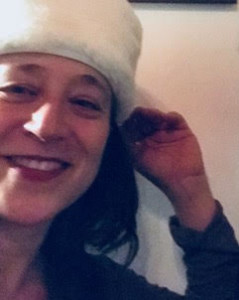 EJB: Do you know why your father had this attitude?
EJB: Do you know why your father had this attitude?
RL: My parents seemed to value invisibility. My mother had been born in Germany and came to the US as a toddler in December 1939. Her uncle survived Auschwitz, but no one in my family was willing to talk about any of this and I always wanted to know more.
EJB: Is this why you became interested in history?
RL: Maybe. I was a history major as an undergraduate at the State University of New York (SUNY) in Albany and got a Master’s in American Social History. My focus was labor. My thesis looked at the way the cigar industry in Binghamton, NY became segregated by gender.
EJB: But you chose to pursue activism.
RL: I wasn’t interested in pursuing further academic study in History. I plunged into activism in New York City, joining ACT-UP and WHAM!—Women’s Health Action and Mobilization.
My job at the time was with the Home Program of the Bond Street Homeless Center run by Catholic Charities. Every night, five of us would load into a van and drive around Brooklyn trying to convince mentally-ill, chemically-addicted people to come to the Center’s drop-in program.
I did this work in 1991 and 1992, until I got a job teaching adult basic education classes for the Consortium of Worker Education (CWE), an educational organization that serves union members. In 1993-94 I taught English in Mexico. When I came back to the US, I returned to the CWE and eventually got a full-time job running an English as a Second Language program at the Painters and Finishers Apprenticeship program in Long Island City.
- No Comments
 Please wait...
Please wait...